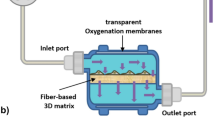The use of drug-loaded nanoparticles is an actively developed approach in targeted cancer therapy. Prevascularized spheroids generated from mesenchymal stem cells and endotheliocytes are considered as a model to evaluate the tropism of therapeutic nanoparticles to a specific tissue. Nanoparticles based on co-polymer of lactic and glycolic acids (poly(lactic-co-glycolic acid; PLGA) labeled with cyanine dye (Cy5) were incubated with prevascularized spheroids, and the rate of their penetration and their distribution in the spheroid-forming cells were evaluated. Endotheliocytes more intensively accumulated nanoparticles than mesenchymal stem cells: the number of nanoparticles in mixed-cell spheroids of mesenchymal stem cells and endotheliocytes was greater than in spheroids built solely of mesenchymal stem cells by 5±1.2 times. The developed 3D in vitro cell model provides a low-cost way to assess tissue tropism of therapeutic nanoparticles under conditions closer to natural in comparison with 2D culture.
Similar content being viewed by others
References
Siddique S, Chow JCL. Application of nanomaterials in biomedical imaging and cancer therapy. Nanomaterials (Basel). 2020;10(9):1700. doi: https://doi.org/10.3390/nano10091700.
Yang Z, Wang D, Zhang C, Liu H, Hao M, Kan S, Liu D, Liu W. The Applications of gold nanoparticles in the diagnosis and treatment of gastrointestinal cancer. Front. Oncol. 2022;11:819329. doi: https://doi.org/10.3389/fonc.2021.819329
Garizo AR, Castro F, Martins C, Almeida A, Dias TP, Fernardes F, Barrias CC, Bernardes N, Fialho AM, Sarmento B. p28-functionalized PLGA nanoparticles loaded with gefitinib reduce tumor burden and metastases formation on lung cancer. J. Control. Release. 2021;337:329-342. doi: https://doi.org/10.1016/j.jconrel.2021.07.035
Yao Y, Zhou Y, Liu L, Xu Y, Chen Q, Wang Y, Wu S, Deng Y, Zhang J, Shao A. Nanoparticle-based drug delivery in cancer therapy and its role in overcoming drug resistance. Front. Mol. Biosci. 2020;7:193. doi: https://doi.org/10.3389/fmolb.2020.00193
Taléns-Visconti R, Díez-Sales O, de Julián-Ortiz JV, Nácher A. Nanoliposomes in cancer therapy: marketed products and current clinical trials. Int. J. Mol. Sci. 2022;23(8):4249. doi: https://doi.org/10.3390/ijms23084249
Lin W, Zhang J, Xu JF, Pi J. The advancing of selenium nanoparticles against infectious diseases. Front. Pharmacol. 2021;12:682284. doi: https://doi.org/10.3389/fphar.2021.682284
Sarkar J, Das S, Aich S, Bhattacharyya P, Acharya K. Antiviral potential of nanoparticles for the treatment of Coronavirus infections. J. Trace Elem. Med. Biol. 2022;72:126977. doi: https://doi.org/10.1016/j.jtemb.2022.126977
Sharmin S, Rahaman MM, Sarkar C, Atolani O, Islam MT, Adeyemi OS. Nanoparticles as antimicrobial and antiviral agents: A literature-based perspective study. Heliyon. 2021;7(3):e06456. doi: https://doi.org/10.1016/j.heliyon.2021.e06456
Waris A, Ali A, Khan AU, Asim M, Zamel D, Fatima K, Raziq A, Khan MA, Akbar N, Baset A, Abourehab MAS. Applications of various types of nanomaterials for the treatment of neurological disorders. Nanomaterials (Basel). 2022;12(13):2140. doi: https://doi.org/10.3390/nano12132140
Joudeh N, Linke D. Nanoparticle classification, physicochemical properties, characterization, and applications: a comprehensive review for biologists. J. Nanobiotechnology. 2022;20(1):262. doi: https://doi.org/10.1186/s12951-022-01477-8
Tchoryk A, Taresco V, Argent RH, Ashford M, Gellert PR, Stolnik S, Grabowska A, Garnett MC. Penetration and uptake of nanoparticles in 3D tumor spheroids. Bioconjug. Chem. 2019;30(5):1371-1384. doi: https://doi.org/10.1021/acs.bioconjchem.9b00136
Ho DN, Kohler N, Sigdel A, Kalluri R, Morgan JR, Xu C, Sun S. Penetration of endothelial cell coated multicellular tumor spheroids by iron oxide nanoparticles. Theranostics. 2012;2(1):66-75. doi: https://doi.org/10.7150/thno.3568
Malinovskaya J, Salami R, Valikhov M, Vadekhina V, Semyonkin A, Semkina A, Abakumov M, Harel Y, Levy E, Levin T, Persky R, Chekhonin V, Lellouche JP, Melnikov P, Gelperina S. Supermagnetic Human Serum Albumin (HSA) nanoparticles and PLGA-based Doxorubicin nanoformulation: a duet for selective nanotherapy. Int. J. Mol. Sci. 2022;24(1):627. doi: https://doi.org/10.3390/ijms24010627
Kumskova N, Ermolenko Y, Osipova N, Semyonkin A, Kildeeva N, Gorshkova M, Kovalskii A, Kovshova T, Tarasov V, Kreuter J, Maksimenko O, Gelperina S. How subtle differences in polymer molecular weight affect doxorubicin-loaded PLGA nanoparticles degradation and drug release. J. Microencapsul. 2020;37(3):283-295. doi: https://doi.org/10.1080/02652048.2020.1729885
Huang HJ, Lee YH, Hsu YH, Liao CT, Lin YF, Chiu HW. Current strategies in assessment of nanotoxicity: alternatives to in vivo animal testing. Int. J. Mol. Sci. 2021;22(8):4216. doi: https://doi.org/10.3390/ijms22084216
Vakhrushev IV, Nezhurina EK, Karalkin PA, Tsvetkova AV, Sergeeva NS, Majouga AG, Yarygin KN. Heterotypic multicellular spheroids as experimental and preclinical models of sprouting angiogenesis. Biology (Basel). 2021;11(1):18. doi: https://doi.org/10.3390/biology11010018
Author information
Authors and Affiliations
Additional information
Translated from Kletochnye Tekhnologii v Biologii i Meditsine, No. 3, pp. 155-160, September, 2023
Rights and permissions
Springer Nature or its licensor (e.g. a society or other partner) holds exclusive rights to this article under a publishing agreement with the author(s) or other rightsholder(s); author self-archiving of the accepted manuscript version of this article is solely governed by the terms of such publishing agreement and applicable law.
About this article
Cite this article
Leonov, G.E., Vakhrushev, I.V., Novikova, V.D. et al. Selective Accumulation of Poly(Lactic-Co-Glycolic Acid) Nanoparticles in Endotheliocytes and Mesenchymal Stromal Cells Cultured as Mixed-Cell Spheroids. Bull Exp Biol Med 176, 241–245 (2023). https://doi.org/10.1007/s10517-024-06003-4
Received:
Published:
Issue Date:
DOI: https://doi.org/10.1007/s10517-024-06003-4




